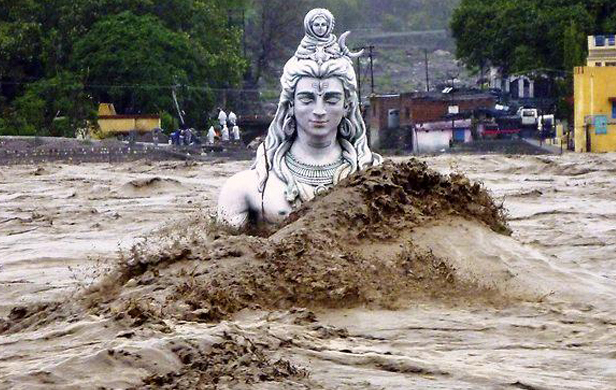
The tragedy of the Calgary flood is mostly being reported in stories, interviews and anecdotes that are rich in heroism, tenacity, resilience, stoicism, determination and sometimes even moments of levity. The unstoppable rising waters of the Bow and Elbow Rivers also brought the adversity that bonded people into a community of incredible co-operation and caring. The flood was an unmitigated disaster. But it happened. And the stories attest to its terrible impact and severity. But little reportage has attempted to explain why it happened.
Calgary’s flood, it seems, is just the latest in a growing frequency of extreme weather events that have been causing havoc nearly everywhere on the planet. Indeed, the list is getting too long to itemize. While Canadian news was fixated on Alberta’s misfortune, the same weather system was causing unusual flooding in south-eastern BC, with implications for the entire eastern watershed of the Rockies. But elsewhere — media attention goes to the most immediate and dramatic — other disasters were occurring. While Calgary was drowning, extreme monsoons with torrential rains of extraordinary intensity were sweeping away entire villages and killing hundreds in India. Colorado was having the worst forest fires in its history. Record floods in central Europe were just subsiding. Northern Mexico and the southern United States are now suffering regular and protracted droughts. Australia — for macabre variety — seems to alternate between unprecedented floods, droughts and fires.
And this is barely a sample. Pakistan, Poland, France, Thailand, Brazil, Japan, Russia and the Philippines have all been traumatized recently by extreme weather events. New York is trying to recover from the 2012 ravages of Hurricane Sandy, and New Orleans from the 2005 impact of Katrina. The city of Toronto has spent at least $700 million repairing the damage from four once-in-a-century floods in the last 20 years. Manitoba hasn’t fully recovered from a 2011 flood that did $1 billion in damage and necessitated another $1 billion in preventative engineering.
The last once-in-a-century flood to hit Calgary was in 2005. The current flood was immeasurably worse — after water levels had subsided considerably, they were still twice as high as the 2005 flood. “Surreal. This cannot be,” was the response of one Calgarian who was trying to reconcile the reality with a recollection of normality. “This is unbelievable,” said another who couldn’t understand how the benign little Bow and Elbow Rivers that usually wander so innocently through the city could become raging monsters. “Completely unprecedented,” said the province’s premier, Alison Redford, “the largest flood in Alberta’s history.” Indeed, this claim has been confirmed by the flood’s unsurpassed speed, level and scope.
To address the disaster, Premier Redford has allocated an immediate $1 billion to assist the pressing task of early cleaning and restoration. Those without access to money will be provided with instant cash. The initial economic damage to businesses is estimated to be $2 billion. The property damage may be $5 billion. A 10-year recovery plan is being designed to return the city to its former pride. What cannot be returned to the city, however, is its former innocence because such events are becoming much more frequent.
This particular flood was caused principally by a torrential rainstorm in the Bow River watershed, a deluge that dropped nearly 250 mm of water in a matter of hours — half as much precipitation as the area usually receives in an entire year. The river swelled to raging proportions, taking out trees, bridges, highways, homes and every obstruction in its path.
Although no individual event of this severity can be attributed to the anthropogenic changes in the planet’s hydrological cycle, the increasing frequency of such events leads to no other likely conclusion. On a warming planet, the rhythms of evaporation and precipitation become more intense. The atmosphere holds and releases greater quantities of moisture. The basic physics of climate change is as predictable as gravity. Many of the details are still uncertain but the science is quite precise about the effects on the hydrological cycle when global temperatures rise. The only uncertainties are the specifics. This time the surprise occurred for Calgary.
Indeed, it is a sad and terrible justice that the “energy capital of Canada”, one of the business centres for the world’s production of fossil fuels, should be the victim of a storm linked to climate change. The full dimensions of the tragedy are not diminished by this coincidence. Significantly, Calgary is also the family home and riding of Prime Minister Stephen Harper, our political leader who has made a disproportionate contribution to thwarting the efforts of the global community to curtail greenhouse gas emissions. Did his helicopter flight over the drowned and crippled city change his thinking?
Calgary is sobering evidence that we will pay for our carbon emissions one way or another. The considered and predictable way is to levy carbon taxes that are sufficiently high to force down the use of fossil fuels and thereby reduce the weather extremes resulting from global warming. The risky and reckless way is to tempt the limits of tolerable temperature increases by continuing with unabated carbon emissions. Then we will pay for the cost of floods, droughts, storms and other extreme weather events that disrupt our agriculture, destroy our infrastructure, traumatize our ecologies and assault our interests in various and surprising ways. Witness the Calgary flood.


Saturday, 13 July 2013 03:30 posted by Roger Kemble
http://www.globalresearch.ca/co2-and-the-ideology-of-climate-change-the-forces-behind-carbon-centric-environmentalism/5342471
Wednesday, 10 July 2013 14:37 posted by Judy Cross
You guys must believe in magic, because of the power you attribute to CO2. It’s a beneficial TRACE gas present at less than 4/100 of 1% in the atmosphere and for which humans are responsible for only 3-5%. Plants use it to produce food for us, more of it makes plants more drought tolerant and because of that, the Earth greened up by 6% over the last 25 years.
The Calgary flood damage was a result of allowing building on flood plains. Poor policy when the risks were long known.
http://www.prweb.com/releases/2013/7/prweb10908388.htm
As for Toronto, I’d look at geo-engineering and cloud seeding for a man-made solution, if indeed there is one.
Tuesday, 09 July 2013 02:26 posted by Damien Gillis
Add Toronto to the list…http://news.nationalpost.com/2013/07/08/heavy-rain-batters-toronto-darkens-skies-in-sudden-storm/
Sunday, 07 July 2013 10:31 posted by Terri Munro
thank you Damien, we were wondering who was going to talk about this.